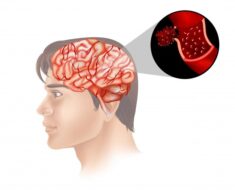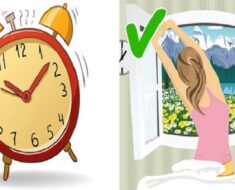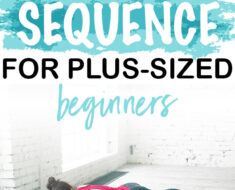If you work an office job or find yourself sitting most of the day, there’s no doubt you experience stiff, tight muscles.
Lower back pain, a sore neck, tight hips – these are all common signs your body needs a good stretch.
These yoga poses are the perfect way to help counteract the effects of sitting all day to relieve you of any discomfort you may have.
12 Yoga Poses to Combat Sitting All Day
Taking 10-15 minutes to perform these poses every day, whether it be all of them or a select few, will help keep any pain and stiffness caused from your desk job at bay.
If you’re new to yoga and aren’t flexible yet, I recommend using a yoga blanket, yoga blocks, and a yoga strap to help ease you into certain poses. I also highly recommend a quality yoga mat, as sitting on the carpet full of dog hair is not the most relaxing environment.
Neck Stretches
Sitting and staring at a computer for 8 hours a day definitely puts a strain on your neck. Coupled with bad posture, it’s no wonder so many people suffer from a stiff, sore neck.
While a stiff neck isn’t necessarily something to be concerned about, learning how to loosen and relieve tension in your neck will make you more comfortable.
This video from Yoga with Adriene will walk you through some basic stretches you can do daily to rid you of any neck pains caused from your office job.
Forearm Plank
Another common problem caused from sitting all day at work is lower back pain.
Often this is due to poor posture, like slouching, which is a result of little to no core muscles to help support your spine.
While stretching is a great way to alleviate tight and sore muscles, building up strength in certain muscle groups can help prevent the pain all together.
One of the best ways to reduce lower back pain is through core strengthening exercises, such as a forearm plank.
The plank is a particularly helpful yoga pose for people who sit all day because it works all 4 abdominal muscles, while also recruiting your back and shoulders.
Performing Forearm Plank:
From push-up position, bend your elbows 90 degrees so your forearms are resting on the floor. Your elbows should be directly under your shoulders, with your hands in front of your face.
With your neck and head inline with your spine, align your hips with your shoulders. You don’t want your hips sinking or piking up, as you won’t get proper engagement this way.
Engaging your core, hold for 45 seconds.
Upward Dog (Urdhva Mukha Svanasana)
Another great yoga pose for people who sit all day is Upward Dog.
Practicing Upward Dog opens up your chest and abdomen while strengthening your back to help relieve lower back pain.
Performing Upward Dog:
Begin laying face-down on the floor.
While stretching your legs back and placing the tops of your feet on the floor, place your hands directly below your shoulders.
Hugging your elbows to your sides, press your hands, thighs, and the tops of your feet into the floor.
Now straighten your arms while slowly send your chest forward and up, keeping the back of your neck long and shifting your gaze towards the sky.
Broaden your collarbones while rolling your shoulders back and down.
At the same time, press the tops of your feet into the mat to lift your legs and hips off the floor.
Exhaling, release your body back down to starting position.
Repeat Upward Dog 3-5 times.
Downward Dog (Adho Mukha Svanasana)
Downward Dog offers a full body stretch, helping relieve any tightness you may be holding onto in your body.
This yoga pose is also a great way to build up strength in your lower back if practiced regularly.
Performing Downward Dog:
Beginning on your hands and knees, tuck your toes under your feet and lift up your legs and hips.
To reduce discomfort on your wrists, shift the weight back by leaning into your heals.
Now move your feet to the edge of your mat, making sure to send the weight to your legs. This will force your legs and arms to become straight, which is what you want.
Slowly lift one heel off the mat while pushing the other heel to the floor, alternating each foot every few seconds. This will provide a deep stretch in your calves and hamstrings.
Stay in Downward Dog for 30 seconds to 1 minute, making sure to focus on your breathing.
Standing Forward Fold (Uttanasana)
Stretch your hips, increase spine flexibility and strength, and relieve pent up tension in your back, neck, and spine with this simple yoga pose perfect for office workers.
Standing Forward Fold, also known as a bend, has a plethora of benefits, and it’s easy to do!
Performing Standing Forward Fold:
Standing straight up, feet planted firmly on the floor, place your hands on your hips and engage your abdominal muscles.
Exhale and bend from the hips, not the waist. The purpose of forward bends is to focus on lengthening the front torso as you move into position.
Keeping your legs as straight as possible without causing discomfort, bring your fingers or palms to the floor slightly beside or in front of you. If it’s difficult to reach the floor, put your palms on your ankles or fold your arms over each other and hold your elbows.
Press your heels into the ground and lift your sit bones toward the ceiling while turning your thighs slightly inward.
Each time you inhale, slightly lift and lengthen your torso. On each exhale, move deeper into the bend so your chest is closer to your legs.
Hold this pose for 30 seconds.
On your way back up, be careful not to roll your spine. Instead, place your hands on your hips, press your tailbone down into your pelvis, and slowly come up while maintaining a long torso. It’s essentially doing the pose in reverse.
If you have tight shoulders, you can try a bind variation where you lift your arms straight up behind your back and clasp your hands together, reaching up towards the sky.
Cobra Pose (Bhujangasana)
Cobra Pose is another great yoga pose to help relieve tension in the lower back.
While you may not notice the difference between Cobra Pose and Upward Dog right away, it’s important to understand they are not the same pose.
The key difference between the two poses is that when performing Cobra Pose, your legs and hips do not come off the ground. Due to this, Cobra Pose is more beginner friendly, so if you can’t quite get Upward Dog, Cobra is the perfect pose to start with.
Performing Cobra Pose:
Begin Cobra Pose by laying face-down on the floor.
While stretching your legs back and placing the tops of your feet on the floor, place your hands directly below your shoulders.
Hugging your elbows to your sides, press your hands, thighs, and the tops of your feet into the floor.
Now straighten your arms while slowly sending your chest forward and up, keeping the back of your neck long.
Broaden your collarbones while rolling your shoulders back and down.
Exhaling, slowly lower back down to starting position.
Repeat Cobra Pose for 3-5 times.
If necessary, you can add a rolled up blanket right under your stomach for added support.
Pigeon Pose (Eka Pada Rajakapotasana)
Known as the “King of Hip Openers,” Pigeon Pose helps open up the hips and alleviate back pain.
Pigeon Pose particularly increases the external rotation of the femur in the hip socket while also lengthening the psoas muscle, a primary hip flexor that connects the torso and legs.
The psoas muscle plays an important role in posture and stabilizing the spine, but often tends to shorten due to excessive sitting.
As a way to combat a short psoas muscle and increase flexibility, Pigeon Pose is a great yoga pose to practice regularly.
Performing Pigeon Pose:
To begin Pigeon Pose, bring yourself onto your hands and knees, with your hands positioned directly below your shoulders and your knees below your hips.
Carefully bring your right knee forward so it’s just behind your right hand. Now move your right ankle over so it’s between your left hip and hand.
For a deeper stretch, move your right leg so it’s parallel with the front of your mat.
From here, slide your left leg back, straighten your knee, and place the top of your foot on your mat. Your leg should be positioned behind you, not over to the side, with your quadriceps squarely facing the floor.
Now lift your left inner thigh up towards the ceiling so you can move your left hip forward so it’s aligned with your right hip. To keep your right hip in place, draw it back and in towards the center of your body.
Your hips should be parallel during Pigeon Pose to prevent any strain on your lower back. If needed, you can place a blanket under your right hip to keep everything in alignment.
Inhaling, come onto the tips of your fingers, lift your upper body, draw your navel in, rotate your tailbone down, and open your chest.
Exhaling, walk your fingertips forward and lower your upper body to the floor, resting your forearms and forehead on the mat.
Stay in Pigeon Pose for 5-8 breaths. On each exhale, focus on relieving any tension that may be in your right hip.
On your final exhale, slow and controlled pull your upper body back up, shift your right leg back, and come back onto your hands and knees.
Repeat for the other side.
Child’s Pose (Balasana)
Child’s Pose is a well-known yoga pose and is the perfect addition to any yoga routine, especially for people who sit the majority of the day.
Practicing this pose helps stretch the hips, thighs, and ankles while also relieving back and neck pain.
Performing Child’s Pose:
Begin on your knees with your big toes touching and your knees wide apart. Tuck your toes and allow your glutes to rest on your feet.
Now crawl your fingertips forward so your arms are extended in front of you on the floor. If your nose is pressing uncomfortably on the floor, you can turn your head to either side to relieve some pressure.
Focus on taking deep breaths and just relaxing.
Stay in Child’s Pose for 5-8 breaths.
Happy Baby Pose (Ananda Balasana)
Happy Baby Pose is the perfect stress reliever, stomach massager, and overall beneficial pose to office workers (or anyone, for that matter).
This pose particularly helps open the hips while also stretching the inner thighs, groin, and hamstrings. It also helps stretch and soothe the spine and sacrum while decompressing the sacroiliac (SI) joint.
This is certainly one of the easier yoga poses but it brings a wide variety of benefits.
Performing Happy Baby Pose:
Begin laying supine on the floor with your knees bent.
Draw your knees in towards your chest and flex your feet so your soles are perpendicular to the floor.
Inhaling, grab the outsides of your feet with your hands. Open your knees slightly wider than your torso, then bring them towards your armpits.
Now position your ankles so they’re directly above your knees with your shins perpendicular to the floor. Flex through your heels for a deeper stretch.
Gently push your feet up towards the ceiling while your hands create resistance by pulling them down.
Stay in this pose for 30 seconds.
Thread the Needle (Parsva Balasana)
If you experience any stiffness or pain in your back, neck, or shoulders, especially due to poor posture, Thread the Needle Pose can provide you with relief.
Practicing Thread the Needle particularly stretches your chest and shoulders, as well as your hips, thighs, and lower back.
Performing Thread the Needle:
Begin this pose on your hands and knees with your hands directly below your shoulders and knees directly below your hips.
Inhaling, extend your right arm out and then up towards the ceiling.
Exhaling, bring your right arm down and under your left arm so that your right shoulder and ear are touching the floor. Your left arm should be bent so that your elbow is directly over your left wrist.
For a deeper stretch, you can push gently with your left arm to rotate your chest towards the ceiling.
Hold this pose for 5 breaths. On the last exhale, push into your left palm while drawing your right arm back out and up. Gently place your right hand back on the mat, and repeat with the other side.
Warrior II (Virabhadrasana II)
Warrior Poses are particularly good at opening the hips, chest, and lungs, which is a much needed pose for people who sit all day.
This pose also helps with strengthening your legs, ankles, shoulders, arms, and back, which is something everyone can benefit from.
Performing Warrior 2:
Beginning in Mountain Pose, step your left foot back so your feet are about 3 feet apart. Rotate your left foot about 45 degrees. Your heels should be in line with one another.
Inhaling, spread your arms wide, reaching your right fingertips forward, left fingertips back. Your neck should be long and your head should be facing forward.
Exhaling, bend your front knee. Your knee should be over your ankle and your shin should be perpendicular to the floor.
Stay in Warrior 2 for 5 breaths. Repeat on the other side.
Garland Pose (Malasana)
Another great hip opener, Garland Pose makes the perfection addition to this sequence of yoga for sitting all day.
Garland Pose has many benefits, including stretching the hips, thighs, ankles, torso, and groin.
At the same time, this pose helps strengthen the abdominal muscles, which helps with posture and relieving lower back pain.
Performing Garland Pose:
Start by standing in Mountain Pose with your arms at your sides, then step your feet as wide as your mat.
Carefully move into a deep squat by bending your knees and lowering your hips. Your thighs should be a little wider than your torso and your spine should be straight.
You may need to place a blanket under your heels for support if you notice them coming off the ground.
Now drop your torso forward slightly and move your upper arms (biceps and triceps) to the inside of your knees.
Bring your hands together in prayer position while pressing your elbows into your knees. Focus on bringing your hands to the center of your chest and your forearms parallel to the floor.
Exhaling, lift and find length in your torso, relaxing your shoulders and keeping your spine straight. Shift some of your weight to your heels.
Hold Garland Pose for 5-8 breaths.





